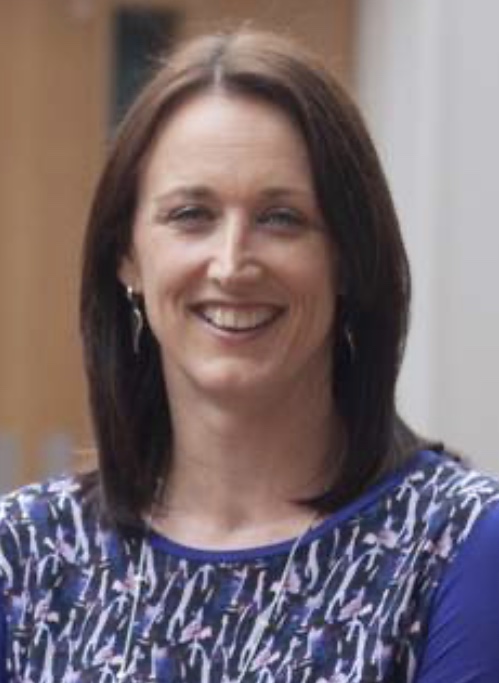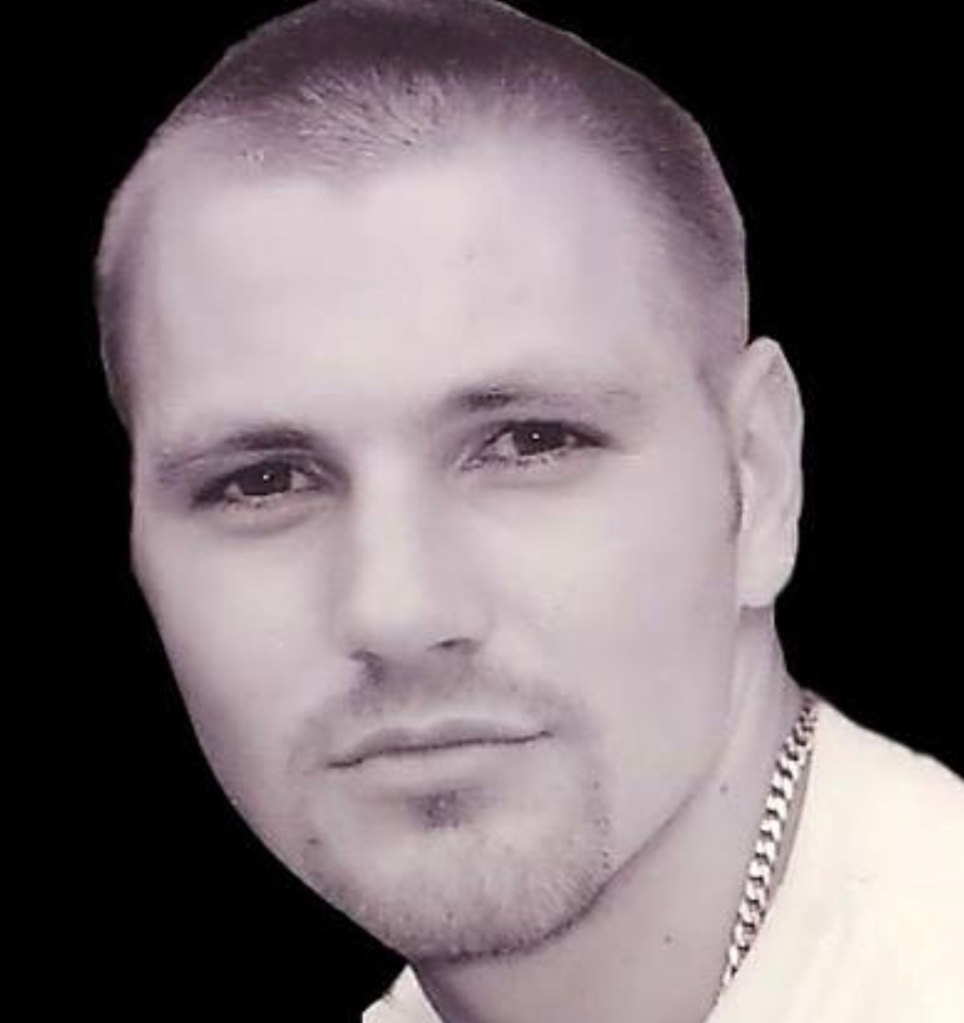Stephanie Bon, Andrew Green & Michael Naughton
Stephanie Bon wrote the following in September 2006 to Andrew Green, CCing Michael Naughton;

Hello Andrew
I was talking to Michael today about an idea that has been at the back of my mind for a while now..
I have been contacted a quite few times by people in our situation whom I always redirect to you, also people who are interested in volunteering and again, I have referred them to you
I had an email last week from a girl from Suffolk (near me); her brother has been arrested by the same detective as Simon and Michael Heath is also the pathologist for the prosecution… there seems to be a pattern emerging…
As the case is awaiting trial she wasn’t able to give me too much information on it but in her words, everything is circumstantial… Anyway, as I said, I offered my support as always and advised her to contact you and Innocent
I was just wondering if it could be good to perhaps try and organise some kind of family support days, perhaps once a month (or more or less dunno yet), initially, just to support people morally maybe? Who knows we could get a guest once in a while, someone with knowledge, even if just to reassure people that they are not alone. We could pass on Innocent details, promote the Innocence Project and generally show people that there is help out there if you know where to look.
I know that when I started, it took me ages to find you and Ann and it’s thanks to you two, I am here today.
I would hate to know of anyone struggling on their own, been there, done that.. it’s tough.
I know that in our case Simon’s parents are completely lost, have no faith and don’t think that anyone is here to help, I know better and this is why I run the campaign.
If anything was to happen, I would want it to be part of Innocent, not as in you do the work (well I would need some advice of course) but as in, this isn’t something I would do off my own back, it would just be great to see Innocent grown and develop down here, the closest we have is London or Kent which isn’t that near and who knows it may be more accessible.
Like I said above, this is just an idea and I would not go ahead without your blessing or proper advice, it’s just something I thought of and I would very much like your feedback on it.
I have copied Michael in as we discussed this today and he knows that my motivation is not for personal gratification, I just want to help people like I get help everyday, even if I just help facilitate it, I’m not sure how many people would be interested but it’s worth a thought
Excerpts from email correspondence from Stephanie Bon to Andrew Green September 2006
The Innocence Fraud Of Sadistic Killer Kevin Nunn
The girl referred to in Stephanie Bon’s correspondence to Andrew Green was/is a woman, and appears to have been the sister of Dawn Walker’s killer, Brigitte Butcher.

Sadistic killer and innocence fraudster Kevin Nunn lost his last appeal the year after Simon Hall’s guilt to his murder of Joan Albert was exposed.
The June 2014 supreme court judgement can be read here.
On the first page of the judgement it can be seen that the UK innocence network chose to intervene in Kevin Nunn’s appeal.
An excerpt from a Bristol university school of law article headed Innocence Network UK at the Supreme Court 13 March 2014 reads;
INUK was granted leave to intervene in the matter because of the experience of its member innocence projects in assisting alleged victims of wrongful convictions to make applications to the Criminal Cases Review Commission (CCRC).
The CCRC is the body that reviews alleged miscarriages of justice and refers cases back to the appeal courts if it is felt that there is a real possibility that the conviction or sentence will not be upheld.
Andrew Green claimed via his twitter bio to be an “expert on criminal cases post trial”.
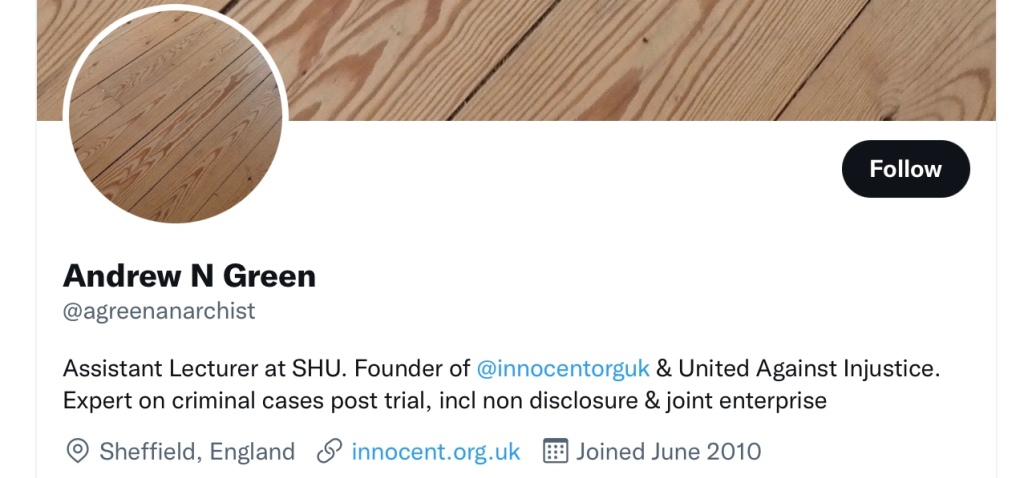
and his Linkedin bio stated he is a case supervisor at the miscarriage of justice review centre based at Manchester university.

Claire McGourlay & Defunct Innocence Network UK
It was reported here that Claire McGourlay set up the Manchester miscarriage of justice review centre in November 2017.
And a university of Sheffield school of law newsletter regarding Claire McGourlay read;
In October 2007 Claire McGourlay set up the first Innocence Project in South Yorkshire.
She secured funding from the White Rose Centre for Excellence in Teaching and Learning in Enterprise.
Her objective was to give students a unique insight into this area of criminal justice.
This project utilises a mentored teaching environment to maximise learning opportunities for students, each Innocence Project (IP) is student-led and centres upon research into alleged wrongful criminal convictions.
Students are involved in reviewing real criminal cases giving them a unique insight, and valuable first-hand experience of the criminal justice process.
Some cases where evidence can be accumulated to support a wrongful conviction are referred back to the Courts of Appeal via the Criminal Cases Review Commission.
The students and the School also became part of a wider national body called the Innocence Network UK (INUK) where the students attend training courses about protocols and professional work.
In fact 14 students attended one such training event in Cardiff 24-26 October 2008.
Innocence produces Sheffield Law Graduates more equipped for professional practice and research beyond their studies and makes them more attractive potential employers.
The teams are already working on their first cases comprising two murders, a rape and a serious assault.
On the 15th April 2008 Claire addressed the INUK national meeting ”Working with campaign groups and victim support groups” at which the Attorney General was present and she has also been invited to sit on the first INUK Committee.
On 30 April 2008 the IP students led a session on the benefits of the project to staff at the School Spotlight on learning and Teaching day.
University of Sheffield School of Law December 2008 newsletter
The Forensic Institute, Allan Jamieson, Tiernan Coyle & Fibre Evidence
During the 11th Annual Forensic Research and Teaching (FORREST) Conference, Glasgow, which was held in 2015, Andrew Green gave a presentation called When is Fresh Evidence Fresh and True? the treatment of scientific expert evidence and experts in the Court of Appeal Criminal Division (CACD) of England and Wales.
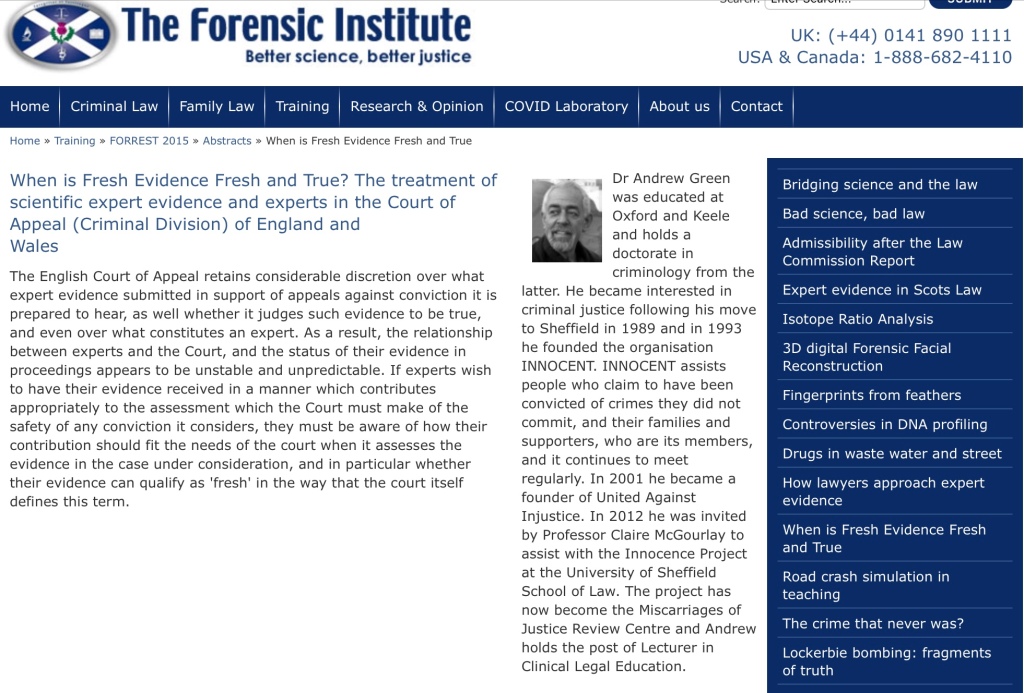
Bad Science, bad law was also included in a list published by The Forensic Institute for the 2015 conference
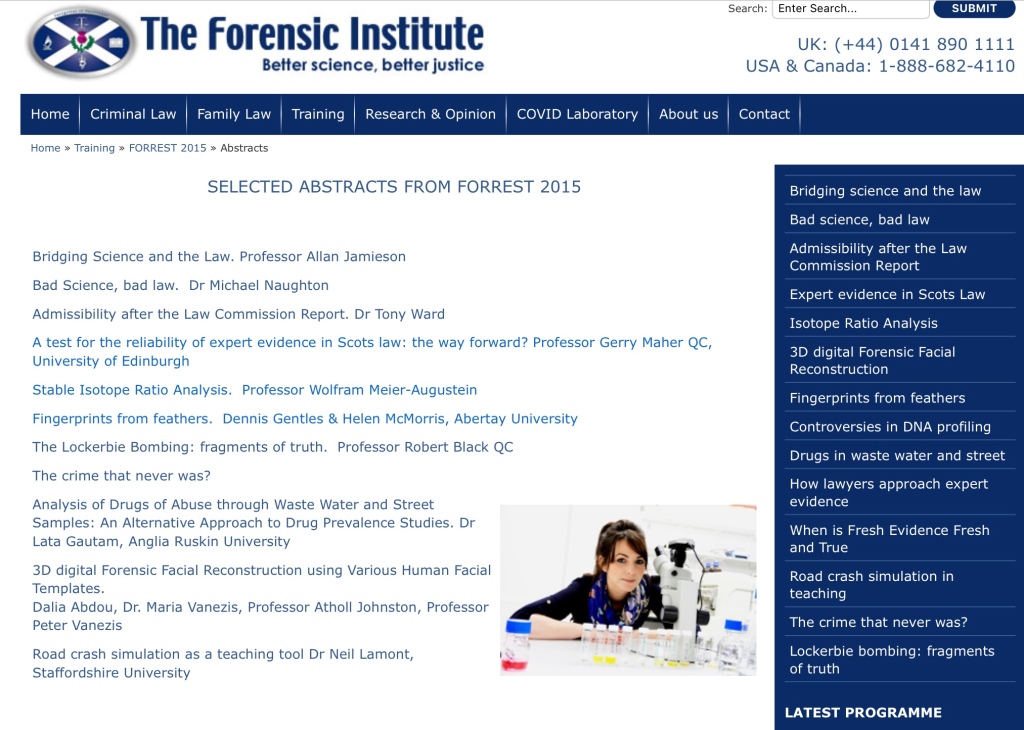
and next to a photograph of Michael Naughton it stated;
I will speak about science and justice as you suggest with examples from the literature and cases that I have worked on that have proven guilt as well as undermine the evidence of guilt.
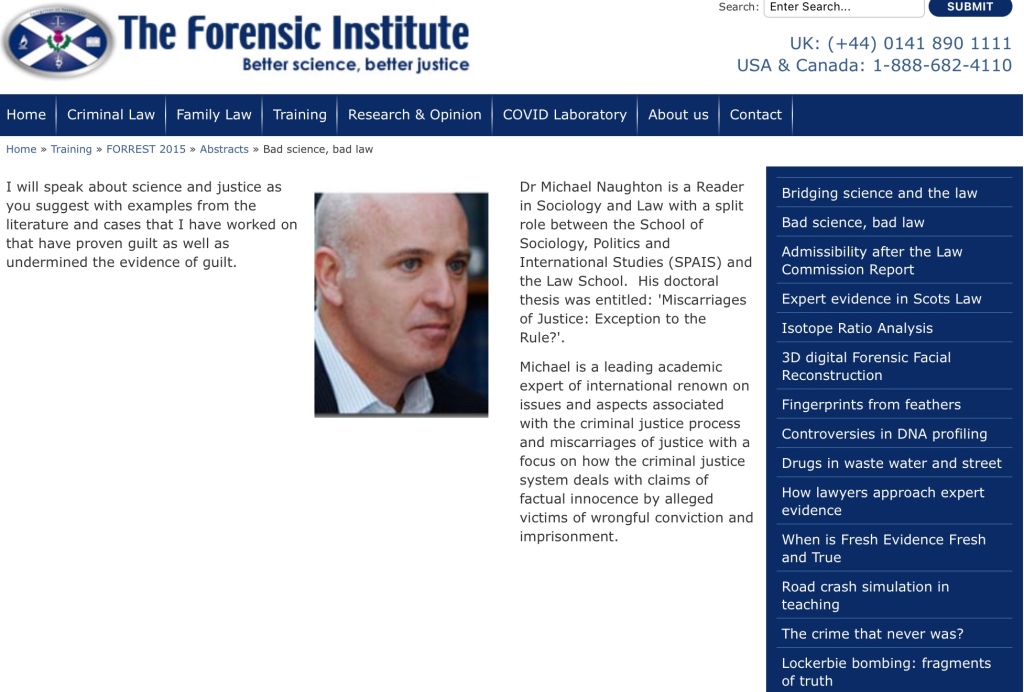
It is not known if Michael Naughton did speak about science and justice as was claimed in the above however Andrew Green, who says he was invited by Allan Jamieson did speak at the event and published his talk – see here for full context;

The same Andrew Green who refers to himself as a “criminologist” and claims to be an “expert on criminal cases post trial” chose to use the case of actual, factual, guilty killer Simon Hall )whose innocence fraud was exposed in 2013) as part of his talk.
Below is an excerpt from hornswoggler Andrew Green’s talk;

To the CACD (Court of appeal criminal division), some forensic scientists must appear to subvert the nature of the evidence on which prosecutors rely.
In the case of Simon Hall ([2011] EWCA Crim 4), the prosecution relied on matching fibres from the crime scene to that found in Hall’s home.
There was no garment to which the fibres might be matched and fibres were of common types, so the proportions of fibres at each scene were compared, and these proportions were found to have matched.
In particular, the prosecution expert instructed for the trial found a small number of uncommon green fibres were found at the scene and at Hall’s home, and it was this that probably convinced the jury to convict Hall.
But at the appeal, a fibre expert, Tiernan Coyle was instructed on behalf of Hall, and he established the fibres said to be green were in fact black and indistinguishable from a large proportion of other fibres from both sites.
The argument (which is long and complicated) centred round the likelihood that the proportions of varying fibres from each site matched.
Coyle’s argument was (if I understand it correctly) that no one knows what proportions of any fibres exist in the environment in general and whether the proportions at the sites differ significantly from fibres which have gathered elsewhere.
Excerpt from Andrew Green’s talk When is Fresh Evidence Fresh and True?
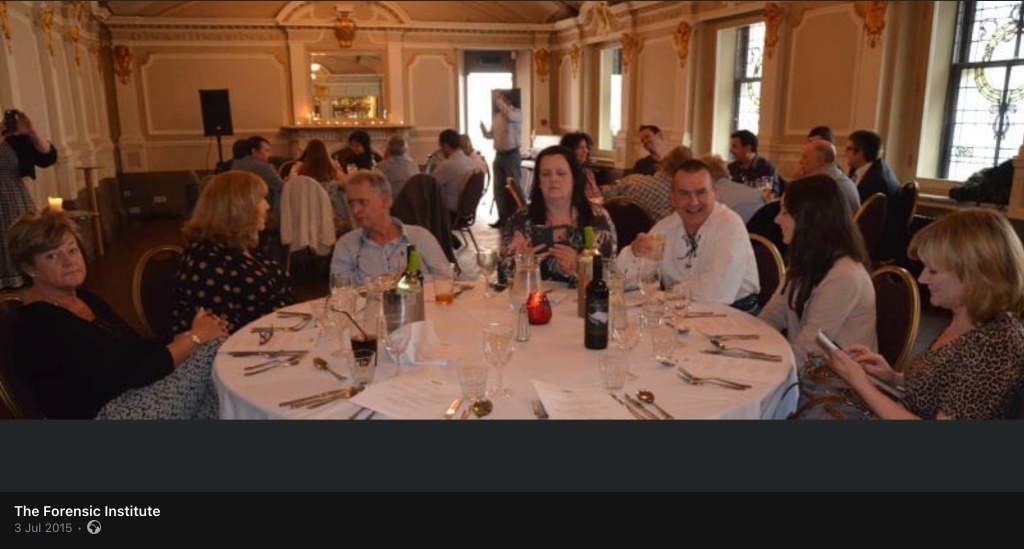

Andrew Green did not attend killer Simon Hall’s trial for his murder of Joan Albert and therefore had no comprehension of all of the evidence presented to the jury.
Therefore his speculative comment on what “probably convinced the jury to convict Hall” is the same type of fraudulent nonsense already demonstrated throughout this blog series, and in other cases of the innocence fraud phenomenon.
The Hall Family’s Concoctions & Stills From CCTV
As have already been highlighted in previous Parts of this blog series, the prosecution relied on a whole lot more than the “matching fibres from the crime scene to that found in Hall’s home” as referred to by Andrew Green during his 2015 presentation.
It is still not known how the criminal cases review commission (CCRC) were able to magic away all the other evidence which was heard throughout Simon Hall’s February 2003 trial.
It is also still not known how the CCRC were able to magic away another main plank of the prosecution’s case, namely the Hall family’s concoctions.
Stills were extracted from CCTV footage of Simon Hall from the time he withdrew cash from the cash point machine located at Tesco’s on Saturday the 15th December 2001, where he purchased the black mole skin type trousers.
These stills were made available to the jury during the February 2003 trial, as was referred to at the foot of page 41 and top of page 42 of the judges summing up here.
Therefore it’s possible the jury were convinced killer Simon Hall was lying with regards the clothes and shoes he said he had been wearing that night and the following morning, as opposed anything to do with the fibre evidence.
For an alleged “expert on criminal cases post trial” it is interesting how criminologist Andrew Green doesn’t question how or why actual, factual guilty killer Simon Hall was wrongly convicted and sentenced for a ‘burglary gone wrong’ as opposed to his murder of Joan Albert having been sexually motivated.


